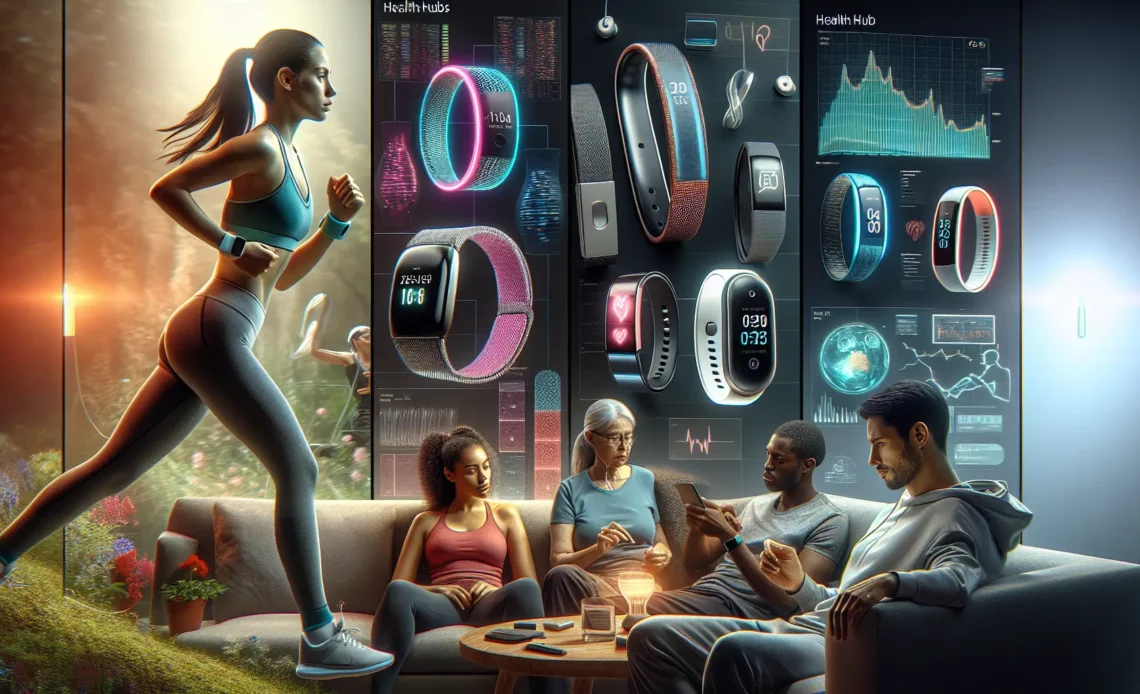Wearable technology in healthcare, ranging from smart wearables like fitness bands to sophisticated devices embedded in clothing, has revolutionized how we monitor and manage health. These wearable devices have become integral in promoting the ‘quantified self’ movement, allowing for enhanced personal health monitoring and remote patient care, thereby minimizing hospital visits.
As wearable tech evolves, it is expected that the number of wearable devices will significantly increase, marking a transformation in how healthcare is administered and experienced by users. The future of wearable technology in healthcare looks promising, with innovations aiming to facilitate better patient engagement and personalized healthcare interventions.
Evolution of Wearable Technology in Healthcare
The progression of wearable technology in healthcare has been substantial, motivated by the necessity for continuous health monitoring and tailored medical approaches. This surge in adoption is quantified by the expected compound annual growth rate of around 38% from 2017 to 2025 in the global wearable sensors market.
Types of Wearable Devices
- Wrist-mounted Devices: These include fitness bands and smartwatches, which are designed to monitor cardiovascular signals, sweat contents, and daily activities.
- Head-mounted Devices: Devices such as smart glasses are capable of monitoring salivary and sweat contents, cardiovascular signals, and health status during physical activities.
- E-textiles (Smart Clothing): These garments integrate conductive devices to monitor biofluids, physiological signals, biomechanics, and physical activity.
- Other Wearables: This category includes smart jewelry, attachable devices, and skin patches, which monitor various physiological signals and biomarkers.
Applications in Healthcare
Wearable devices in healthcare are pivotal across four main application areas:
- Health and Safety Monitoring: Devices are used to continuously monitor vital signs and detect potential health issues early.
- Chronic Disease Management: Wearables play a critical role in managing ongoing health conditions by providing constant monitoring and data collection.
- Disease Diagnosis and Treatment: These devices assist in diagnosing diseases and delivering real-time health insights to healthcare providers.
- Rehabilitation: Wearables support the rehabilitation process by tracking recovery progress and adjusting treatment plans accordingly.
Notably, wearable medical devices facilitate a connected health environment, linking doctors, patients, and healthcare systems to improve disease management and patient care. Moreover, the extensive review published in the JMIR Mhealth Uhealth journal in November 2020 underscores the potential of wearable devices in healthcare, although it calls for further research to expand applications and address existing limitations. The research was conducted by experts from the Department of Orthopaedic Surgery at Union Hospital, Tongji Medical College, Huazhong University of Science and Technology, Wuhan, China.
Impact of Wearable Technology on Patient Care and Health Management
Wearable technology significantly impacts patient care and health management by providing continuous health monitoring and real-time data feedback. Medical-grade wearables, which require FDA clearance, are used in clinical decision-making, while consumer-grade devices focus on self-monitoring wellness and health. The integration of these devices with electronic health records through open APIs enhances the holistic view of patient health and supports personalized treatment plans.
The growing market of smart wearables, although currently lagging behind other connected devices, shows potential with a user base that includes over a quarter of the US population. This expansion is anticipated to diversify into areas such as augmented reality (AR) and virtual reality (VR). The primary use of wearables remains fitness tracking, but their applications are broadening.
Artificial intelligence (AI) plays a crucial role in enhancing the functionality of wearable devices, allowing them to provide personalized health updates and track vital health metrics like heart rate and sleep patterns. The market for wearable technology, valued at approximately $115.8 billion in 2021, is expected to surge to $380.5 billion by 2028. This growth is driven by the increasing adoption of health and fitness trackers, which not only monitor physical activities but also provide insights into health trends and abnormalities.
Healthcare providers leverage wearable technology to offer better patient support and education, improving treatment adherence and patient outcomes. These devices facilitate remote patient monitoring, especially for those with chronic conditions, and provide clinicians with real-time, objective data that can be integrated into medical records for more personalized care.
Furthermore, wearables empower patients by promoting self-management of their health through features like medication reminders and progress tracking, which support behavior changes and enhance treatment compliance. Innovative features in wearables, such as continuous glucose monitoring and wearable ECG monitors, provide patients with critical health insights without invasive procedures, thereby improving the quality of life and preventive care.
Overall, wearable technology in healthcare not only supports current health management practices but also paves the way for future advancements in medical care, making it an indispensable tool in the evolving landscape of healthcare.
Future Innovations in Wearable Medical Devices
The rapid advancement of wearable medical devices is set to transform healthcare with a host of innovative technologies. The integration of 5G connectivity is poised to enhance medical devices by enabling faster data throughput and sophisticated analysis using ML/AI algorithms. This technological leap will facilitate real-time health monitoring and more precise diagnostics.
AI-powered platforms are revolutionizing wearable technology by improving the accuracy of health diagnoses and enabling continuous health monitoring, thus personalizing healthcare like never before. Additionally, telemedicine is being reshaped by innovations in wearable devices and the Internet of Things (IoT), enhancing the precision of remote diagnosis and disease prediction.
Emerging startups are focusing on developing specialized sensors for wearables, such as accelerometers and optical and bioimpedance sensors, which are crucial for advancing the functionality of these devices. The field of sleep management is also seeing significant innovations with the development of smart dental wearables and vision glasses designed to manage sleep disorders effectively.
Furthermore, wearable robotics, such as exoskeletons, are supporting physical rehabilitation by reducing the need for provider assistance, thereby empowering individuals with disabilities. Epidermal wearables represent another breakthrough, with subskin sensors that monitor vital parameters including heart rate, temperature, and blood pressure, enhancing chronic patient management.
Smart clothing integrated with sensors is paving the way for non-invasive health data collection, providing insights into vital signs and environmental factors affecting health. The application of fitness trackers is expanding beyond general wellness to include clinical care, improving the accuracy and reliability of remote patient monitoring and telemedicine.
The potential of wearables is further underscored by projections showing the global market for wearable healthcare devices reaching nearly $70 billion by 2028, with an annual growth rate of over 11%. Innovations such as the app developed by the Snyder Lab, which can detect infections like Lyme disease and COVID-19 before symptoms appear, highlight the future possibilities of wearable technology in healthcare.
As we look to the future, wearables are expected to become less intrusive and more adaptable, potentially becoming invisible and seamlessly integrating into everyday clothing. This evolution will continue to drive the growth of both consumer and medical-grade wearables, leading to smarter applications, more reliable devices, and enhanced measurement accuracy.
Challenges and Ethical Considerations in Wearable Technology Adoption
Data Privacy and Security Concerns
- Vulnerability to Hacking: Wearable devices may have system vulnerabilities that can be exploited by hackers, posing potential threats to users.
- Misuse of Personal Data: Companies may misuse personal data, which necessitates greater transparency about the usage of personal data.
- Prioritization Issues: Some companies prioritize the multifunctionality of devices over data safety, potentially leading to data leakage and privacy violations.
- User Awareness: It is crucial that users improve their awareness and knowledge to protect their personal data.
Technical and Operational Challenges
- Miniaturization Issues: Wearable technology faces challenges in technology miniaturization, impacting reliability, stability, and usability.
- Data Utilization: Despite the vast amount of medical data captured, data utilization remains low, presenting a challenge in fully leveraging the information.
- Accuracy in Dynamic Environments: The accuracy of data collection by wearables can be compromised in dynamic working environments.
- Influence of Physical Factors: Factors like skin temperature and mechanical strain can affect the accuracy of sensors like photoplethysmography (PPG).
Health Risks and Ethical Issues
- Physical Risks: Common risks include skin irritation, electrical shock, radiation exposure, chemical exposure, and infection.
- Ethical Research Practices: Ensuring informed consent and minimizing risks in human research studies, especially for first-in-human (FIH) trials, is critical.
- Privacy in Research: Protecting the privacy and data confidentiality of research participants is paramount, with informed consent being a key ethical and legal requirement.
Regulatory and Standardization Needs
- Need for More Regulations: Regulations for emerging products like smart glasses are often neglected, highlighting the need for more robust privacy protections.
- Standardization and Risk Management: There is a need for standardization in regulations, technical requirements, and risk management in both hardware and software of smart wearables.
- Education and Collaboration: Universities and academia can play a significant role in educating the public about the benefits and challenges of smart wearables through collaboration with industry and healthcare sectors.
Data Handling and Third-Party Issues
- Third-Party Access: Data is often stored in the cloud, and access is granted to companies and researchers, which can lead to concerns regarding data privacy and security.
- Unclear Data Usage: It is often unclear how data shared with third-party apps and services is being used, posing a risk of data breaches and identity theft.
- Need for Stronger Regulations: While regulations like GDPR and HIPAA provide some protection, there is a need for stronger regulations and industry self-regulation to safeguard personal health data.
FAQs
How is wearable technology transforming the healthcare industry?
Wearable devices are revolutionizing healthcare by continuously gathering a vast array of real-time health data, which includes vital signs, physical activity, sleep patterns, and more. This influx of detailed information enables healthcare providers to make more informed decisions by offering a clearer view of a patient’s health over time.
What advancements are occurring in wearable technology?
Wearable technology, including smartwatches, is advancing through enhanced capabilities. These devices now offer a broader range of features such as sophisticated health and fitness monitoring, GPS navigation, and the ability to make mobile payments.
What effects have wearable devices had on health and wellness?
Wearable devices have significantly impacted health and wellness by fostering health education and empowering patients. Individuals now have the ability to monitor their health data in real-time, which previously required visiting a doctor. Wearable technology provides the convenience of tracking health and wellness from home or while on the move.
In what ways has wearable technology been revolutionized?
The revolution of wearable technology is characterized by the integration of advanced microprocessors, artificial intelligence (AI), virtual reality (VR), and the Internet of Things (IoT). These innovations have led to the creation of smart garments, jewelry, shoes, and various applications such as activity trackers and motion-sensing keyboards, all designed to simplify tasks and connect users to a broader network.



